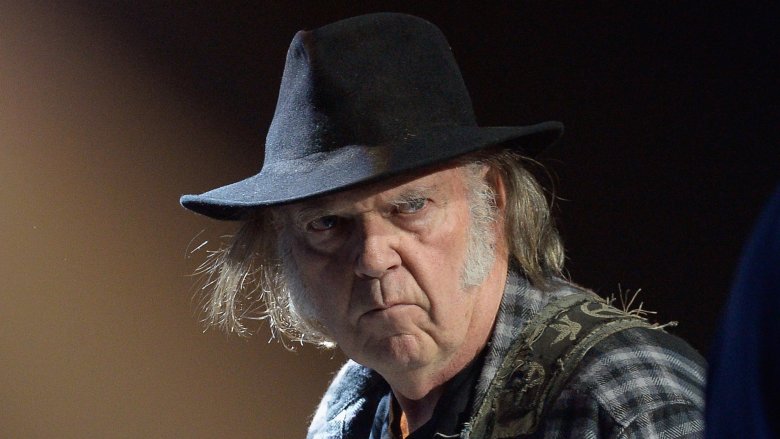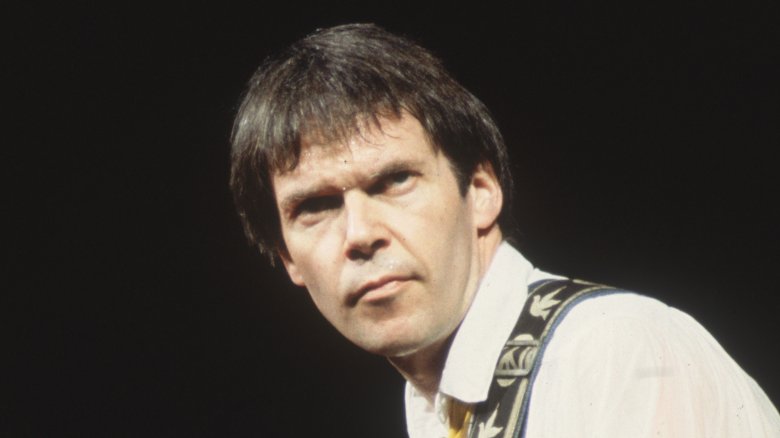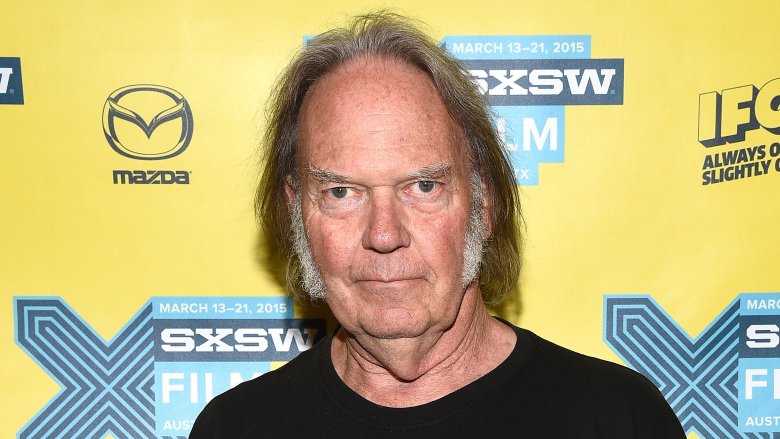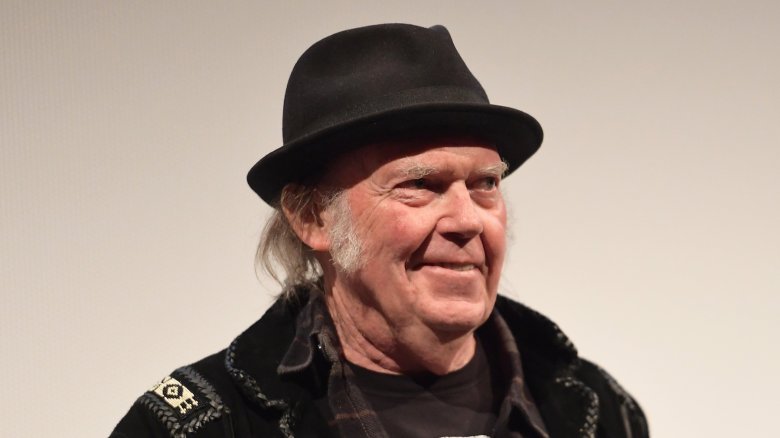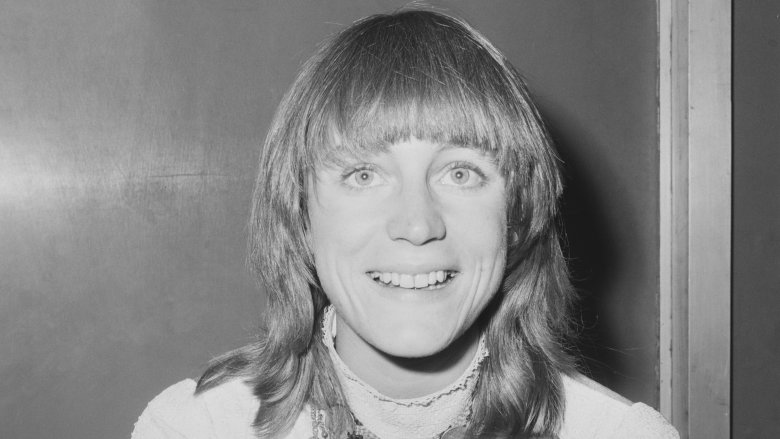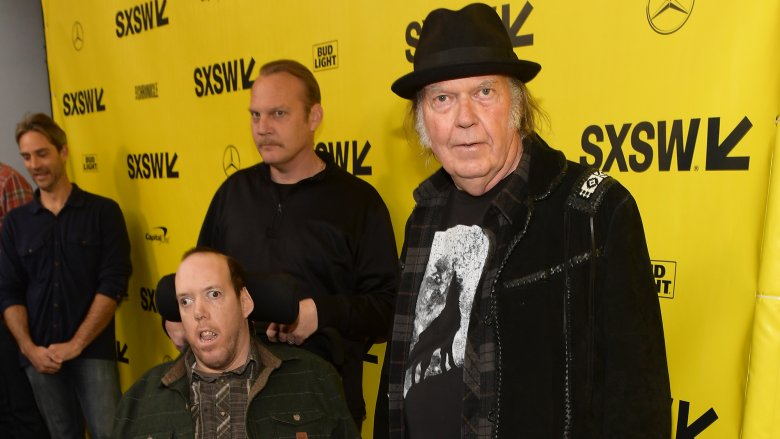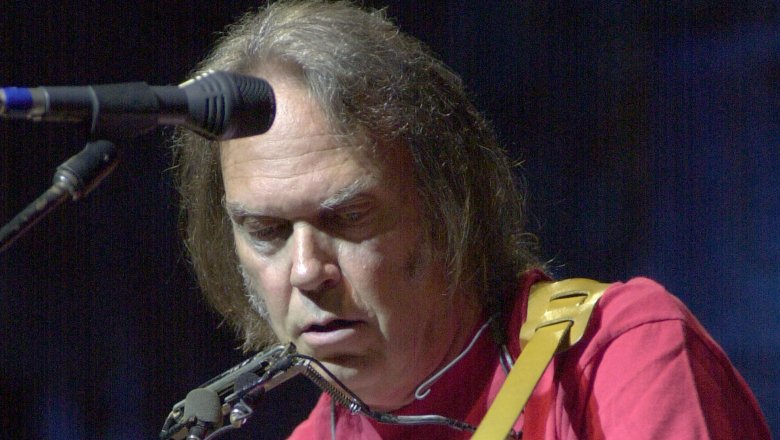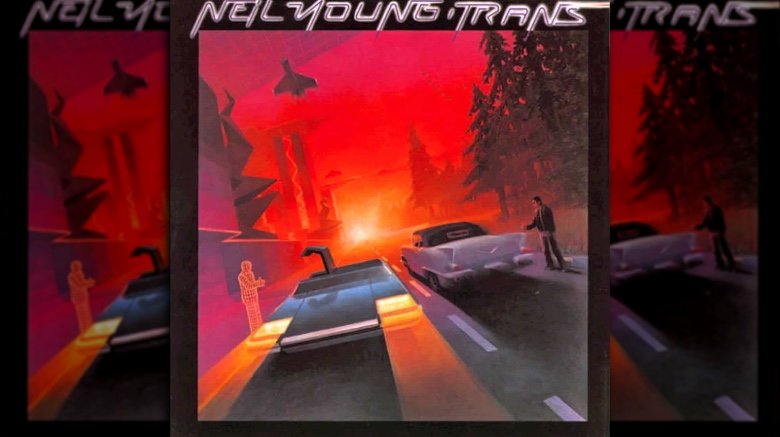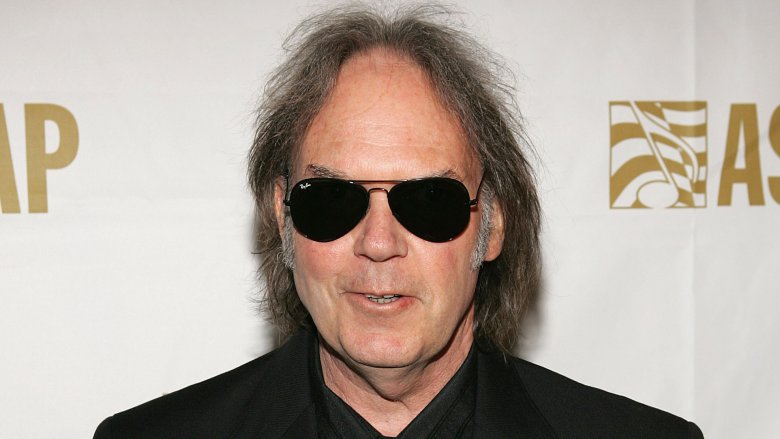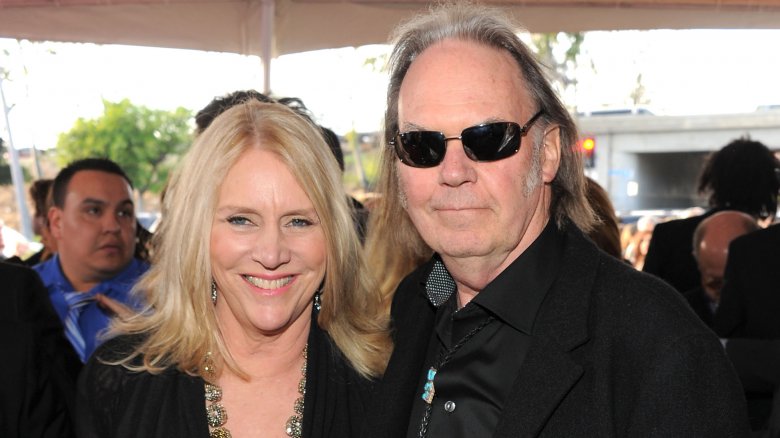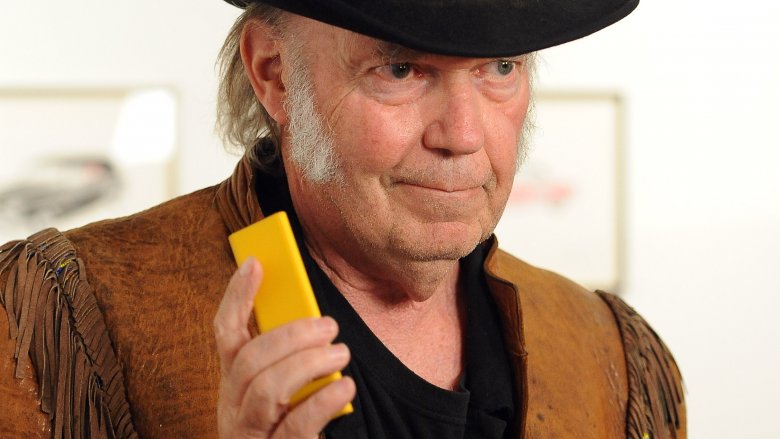The Tragic Real-Life Story Of Neil Young
Through an early band in Canada with Rick James, as a member of Crosby, Stills, and Nash (and Young), and a prolific solo career, Neil Young has carved out a distinctive sound and a distinctive identity. He's a little bit country, and a little bit rock n' roll ... but he's also a folkie with a high and sweet voice, who plays the guitar in a raw, grungy way that hinted at the "Seattle sound" decades before Pearl Jam formed. His image is as singular as his music: He usually performs in a baggy old shirt, with his hair a mess, matching the vibe of his often sad and pained songs.
Young doesn't look or act like a fancy rock star, and his music reflects that — because his life has had plenty of moments that are more "Needle and the Damage Done" than "Party Rock Anthem." Neil Young has lived through a lot of heartbreak, tragedy, and difficulties, but he's kept on rockin' in the free world for more than 70 years. Here's a look at how Neil Young has suffered, both for his art, and because life is just that way sometimes.
Neil Young was born too early to benefit from the polio vaccine
Vaccines are a cure in the sense that they prevent whoever receives them from acquiring a disease. They don't eliminate a disease that's already afflicted a person. Jonas Salk's polio vaccine was widely distributed in the mid-1950s, saving millions from paralyzation and days spent in iron lungs. But for Neil Young, born in Canada in 1945, that all came too late.
In his memoir, Waging Heavy Peace, Young remembers being "about five years old" in 1951, and his parents rushing him to Sick Children's Hospital in Toronto, and that "it was hard for [him] to walk for some reason." A painful lumbar puncture ("that hurt like hell and scared me to death") revealed what his doctor feared: Young Neil Young had polio. The disease had ravaged his body, and his brother, Bob Young, recalls a lengthy hospitalization, after which Neil had to re-learn how to walk. "I remember him trying to get from one part of the living room to another by hanging on to furniture to keep his balance," Bob Young said. "He was unsure of what had happened with his battle with polio. 'I didn't die, did I?' He said."
Young felt the wages of polio well into adulthood. Lower back vertebrae were surgically removed, and he frequently wore a back brace, even during concerts.
Neil Young's family broke in half
After some time growing up in rural areas outside of Toronto, Neil Young and his family settled in the tiny, remote town of Omemee, Ontario. A few years after the childhood trauma of polio, and then the daunting task of learning to walk again, Young faced another painful event: The slow deterioration of his parents' marriage.
According to Young's bio on his website, his parents, Scott and Edna Young, fought about a lot of things, but the prime issue was Scott's wandering eye and flirtatious nature. After a move back to the Toronto area, Scott left the family, including 12-year-old Neil, in order to be with another woman. The elder Youngs divorced, and devised a unique custody arrangement. Rather than have kids Neil and Bob split their time between Mom's house and Dad's house, Neil lived with his mother, and Bob stayed with their father.
While Neil and Bob somehow managed to remain close over their lifetimes, it's likely that the literally split-in-two family rarely saw each other in the following years, as Neil and his mother moved over a thousand miles away to the city of Winnipeg.
Neil Young suffers from diabetes and epilepsy
When Neil Young was a child, he was diagnosed with type 1 diabetes, reports Biography. Also called "juvenile diabetes" because it's historically beset children, it's a hormonal disorder in which the body cannot regulate blood sugar because the pancreas doesn't make insulin, according to JRDF.
Young also suffered from epilepsy. While likely not his first seizure, one such episode in 1967 remains memorable for him. He was hanging out a radio festival called the Hollywood Teen Fair, when he suddenly found himself "on my back on the pavement," as he wrote in Waging Heavy Peace. "I was having fun, and you know, maybe I'd forgotten to eat or something, I don't know. And then I felt kind of sick to my stomach, and then I started to feel all weird and echoey, and then I fell down, and I don't really remember afterwards," Young said on NPR's Fresh Air.
He continued to suffer seizures, a telltale symptom of epilepsy, into the '70s, telling Rolling Stone in 1975 that he'd never had one while performing, because he "always left the stage" when he could feel one coming on. As of 2012, however, the rocker told NPR, "They don't happen anymore. I think I outgrew them."
Neil Young left the mother of his first child high and dry
Plenty of people see an actress in a movie and develop a serious crush, but famous people can actually maneuver to meet that person. According to People, Neil Young saw the 1970 movie Diary of a Mad Housewife, and became transfixed with its star, Carrie Snodgress (above). Young tracked Snodgress down to the theater where she acting in a play. (Creepy.) "There was a note on my dressing room table that said, 'Call Neil Young.'" By 1971, the couple was living together, and in 1972, their son Zeke, was born, and diagnosed with cerebral palsy. By 1975, Young was done with the whole family thing. "He started hanging out with the guys, going to L.A. alone," Snodgress said. "Then one day he came back and said he thought it was time for me to leave." After he kicked them out, Young moved his ex-partner and their son around a series of L.A. rental houses until he gave her a house and gave her substantial amounts of unofficial child and spousal support payments.
Over the years, taking care of Zeke cost more and more while Young's financial assistance — Snodgress scaled back her acting career on hold to care for a child with special needs — grew inconsistent. In 1983, Snodgress took her case to a Los Angeles court, which ordered Young to make $10,000 monthly child support payments.
Neil Young's kids have had medical issues, too
Neil Young's first child, Zeke (above middle), was born in September 1972. Doctors diagnosed cerebral palsy, and attributed his paralyzation to prenatal brain damage. He also suffered from developmental delays, such as being unable to talk until after his second birthday (and after extensive therapy). He eventually overcame most of those physical setbacks, and suffers from permanent limited mobility in one arm and one leg. Zeke Young's mother, actress Carrie Sondgress said that after she and Neil Young split up, Zeke rarely saw his father.
Neil Young moved on to marry the former Pegi Morton, with whom he had two children, a son named Ben (above left) and a daughter named Amber Jean. Like their half-brother (and their father) both Ben and Amber Jean were diagnosed with chronic medical conditions early in life. Doctors diagnosed Ben Young with cerebral palsy, which manifested in quadriplegia and the inability to speak. Amber Jean developed epilepsy.
Neil Young killed an album because it was too emotionally intense
In 1975, Neil Young recorded a stark, mostly acoustic album called Homegrown. His label at the time, Reprise Records, had accepted the LP, finalized the cover art, and set a release date. Then Young held a listening party, playing the record for about ten people. They liked it fine, but then the reel kept playing, which contained another unreleased album called Tonight's the Night. (If Neil Young is anything, he's prolific.) "By listening to those two albums back to back at the party, I started to see the weaknesses in Homegrown," Young told Rolling Stone. And so, he decided to release Tonight's the Night, because "the general feeling" of that more straightforward rock n' roll record was "much more elevating than Homegrown." Why so serious? "A lot of thee songs had to do with me breaking up with my old lady," Young said. "It was a little too personal...it scared me."
That "old lady" was, presumably, Carrie Snodgress, meaning Young hadn't acted as cruelly or callously as it seems like he did. He'd just taken his pain and sadness and made it into art. But the result was so raw that Young didn't only pull it off of Reprise's release schedule, he completely buried it. Homegrown, recorded during Young's mid-1970s peak, remains unreleased, as of this writing. However, in April 2019, Rolling Stone reported Young had planned then once again delayed its release.
Neil Young got sued for being a caring father
In 1982, Neil Young signed with Geffen Records, which offered a contract that paid a minimum of $1 million per album. The first record he made under this deal was Trans, a 1983 collection of electronic music with garbled computerized voices all over the place. While electronic music was on the rise in the early '80s, Young's real inspiration for Trans was his son, Ben, born with cerebral palsy. "My son is severely handicapped, and at that time was simply trying to find a way to talk, to communicate with other people," Young told Mojo (via Thrasher's Wheat) in 1995. "That's what Trans is all about. And that's why, on that record, you know I'm saying something but you can't understand what it is. Well, that's the exact same feeling I was getting from my son."
And what did Neil Young get for this profound attempt to connect with and understand his son? He got served. In November 1983, Geffen sued Young for $3.3 million on the grounds that Trans and some other works were "not 'commercial'" and "musically uncharacteristic of Young's previous recordings." In other words, Geffen sued Neil Young for not sounding enough like the Neil Young they'd paid so much to get on its roster. Young countersued for $21 million, and in a few months time, both suits were dropped.
An aneurysm could have killed Neil Young
Since childhood there have been two constants in the life of Neil Young: music and more than his fair share of scary health problems. He's survived and recovered from polio, managed epilepsy and type 1 diabetes, and in 2005, he suffered brain a brain aneurysm.
In March 2005, Young performed with the Pretenders at the Rock and Roll Hall of Fame. According to his publicist (via Billboard) it was while playing on stage that he noticed "visual field disturbances." He went in for an MRI scan, where doctors discovered that he had an aneurysm, which is described by Mayo Clinic as "a bulge or ballooning in a blood vessel in the brain." A ruptured or leaking aneurysm can lead to either decreased blood flow to the brain, or death. This medical situation can often be treated with surgery, and Young's case qualified ... although he delayed that potentially life-saving surgery for a week to go record something in Nashville. Finally, he went under the knife, and his procedure was declared "a complete success." The part about the ordeal that truly seemed to bug the Canadian-born Young was that his recovery time forced the cancelation of an appearance at the Juno Awards (the Canadian equivalent of the Grammys).
Neil Young left his wife for a movie star
Back in 1974, while he was still partnered with Carrie Snodgress, Neil Young met Pegi Morton (above), a waitress in her early 20s, who worked near his Broken Arrow Ranch in northern California. Young ditched Snodgress, and married Morton in 1978. In addition to helping to found the Bridge School, a world-class institution for children with special needs (like her son, Ben, who has cerebral palsy), she performed as a backup singer for her husband, and finally released her first album in 2007.
Pegi Young's completed her final album, Raw, in 2017, essentially a concept album about divorce. In 2014, Neil Young filed divorce papers, and took up with Splash and Kill Bill star Daryl Hannah. Here are some of Pegi Young's lyrics about this dark time: "You hurt me so bad / you were the best love I ever had," and "Why'd you have to ruin my life? Why'd you have to be so mean?" So while Neil Young might not look or act like a party-hearty rock star, he did the most rock star thing ever, just shy of his 70th birthday, and left his wife for an actress. (Pegi Young, by the way, died of cancer in January 2019.)
Neil Young's house burned down (twice)
2018 was one of the worst years on record in terms of California wildfires. Blazes tore through both the northern part of the state (the Camp Fire) and the southern end (the Woolsey Fire), claiming millions of dollars worth of property and a significant number of lives, according to CBS News. Fires don't discriminate, and the Woolsey burned through Malibu, that beautiful beachside Southern California enclave where countless celebrities call tasteful, modern-style mansions home.
A lot of famous people lost a lot in the fires, including Gerard Butler and Miley Cyrus, who each lost a house. As did Neil Young. He bought his home for $3.6 million from girlfriend Darryl Hannah before they married, only to see it burn down. As if that's not tragic enough, it's not the first time this has happened to Young.
"I have lost my home before to a California fire, now another," he wrote on the Neil Young Archives. He was also very clear about what he thinks is the root cause of the loss (and the fires). "California is vulnerable — not because of poor forest management," he wrote, but, "because of Climate Change."
Neil Young wanted to make the next iPod but made the next Zune instead
It's probably not too surprising that Neil Young, a prolific, exacting, and versatile musician who produces his own albums, is something of an audiophile. To that end, Young announced in 2014 that he planned to take on Apple with a personal music player that offered significantly higher-quality audio files, more comparable to the rich and nuanced sound of vinyl than the compressed vibe typical of digital music. To fund what he called the PonoPlayer Young launched a Kickstarter campaign which earned more than $6 million, eight times his goal and one of the biggest crowdfunding campaigns ever.
The yellow PonoPlayer, with a 128 gigabyte capacity, which allowed for the storage of several hundred songs, went on sale in January 2015 at a cost of $400. The device sold well enough, but Young said his pet project was doomed when the record labels who'd provide the high-res music wanted to charge extra for high-quality music. His dream of bringing really good digital music to the masses died, ultimately unable to break into a marketplace dominated by Apple's iTunes, and how streaming was well on its way to replacing downloading as the music delivery method of choice by the time consumers could get a PonoPlayer in their hands. In July 2016, Apple actually bought out Omnifone, a music software service that contracted with a number of companies ... including Pono. In other words, the giant ultimately killed the giantkiller.
